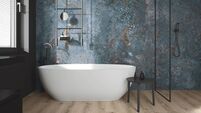The ultimate robot vacuum guide for Irish buyers

Eufy has just introduced a robot vacuum with a manual stick vacuum stored at the docking site. Itís a LiDAR/camera guided robot vacuum (no mopping) that can take on 135 sq/m on a single charge. Priced from €350, various suppliers.
Ready to let your little automatic friend suck up a repetitive, boring chore? Here’s your guide to getting aboard the robot vacuum craze.
Robot vacuums are, for most of us, not a replacement for a manual vacuum for heavy cleaning and dealing with carpets at least every couple of weeks. They are primarily dust collectors — fantastic for helping to keep hard flooring and flat pile soft flooring. Robots feature brushes, beater bars, and side brushes like any conventional vacuum, compacted into the circumference of their little chassis. Motor/suction power is measured in pascals (Pa). 2,500Pa to 5,000Pa would be standard, with 3,000Pa relatively powerful. The very best machines (it’s impossible not to point to the Dyson 360 here at 22,000Pa for about €1,000) will do two runs — taking up loose debris in an initial sweep, before returning to deep clean at a higher suction power with intense brush work.
A good machine will react to the conditions of the flooring, boosting where needed — but perfect human-steered performance? Don’t expect miracles. If you’re going to be at home while the machine is running, look for the lowest decibels (dB) you can find, and choose a machine low enough to scoot under your favourite sofa. There are an increasing number of Chinese-made machines in the €200–€300 bracket available online. Follow independent customer and media reviews to ensure their build quality and performance match the deal. Basically, the more hands-off it is, the more convenient and pricier the robot will be, and without a water reservoir and damp-dust, that could be as much as a month.
The length of the run for your machine is determined by the battery’s power, and the deployed power demanded by the size and options of the motor. Ideally, we want the area cleaned in one go. This could be 40 minutes (regarded as plenty in a manual battery wand) or well over two hours without repeated, energy hungry boosts on a filthy floor. The pauses between these runs will depend on the speed at which the machine recharges at the docking station. Two to six hours of charging would not be unusual even in a top machine. If you’re away all day, the length of runs and recharge times will matter less, as you simply won’t be there to get irritated. Even a powerful motor working on a really dirty floor will have a shorter run time (obviously). In short, you let the machine map the room if it has that level of smarts (see more on that below). You then schedule the run for whatever time of day or whatever days suit you, and if there are customisable features for individual rooms, these are set on the app for your machine. It’s set-and-forget together with extras runs for special occasions or domestic disasters. If the machine is rated for the range of the floor, the recharges will only occur between daily services.
This is how your little, autonomous cleaning buddy systematically trundles around the spaces in a logical order that covers the entire floor. Navigation segues into other performance talents, so take note, and don’t buy even the cheapest machine without some form of app operation. Navigation comes in four flavours. Bump-and-run, IR sensors, camera mapping, and the top-tier technology — LiDAR. Bump-and-run is the most basic system featured on affordable robots and combos like the Eufy G50 hybrid. For many families, a machine at this price point is perfectly adequate at €199.99 with a low noise of just 55dB and a 200ml on-board water tank. Bump-and-run sets your vacuum off on a methodical journey with a set-up and down route where the machine will touch off and then glide around objects rather than actively scanning. Some cheap robot vacuums will utilise good old IR to sense when they are about to crash into something.
Camera mapping (these are really sensors), also known as vSlam, sets out a route in real time. Each time it wheels around objects without collisions, braking at predetermined “no-go” areas marked out by magnetic boundary strips. vSlam won’t get into an uproar if you shuffle up the furniture one afternoon, as it maps each outing, triangulates its visual readings, and will “see” the room as it is on that day. Obviously, it needs a well-lit room to work well.
LiDAR uses lasers and sensors to come up with a virtual map using “light detection and ranging,” and its integrated software can “learn” as it services your floors week after week. It’s the sophistication of this ability to learn, to actively avoid obstacles and to clean intuitively (boosting the motor and lifting or dropping brushes) that will push up the price of your machine. If you have large, complex rooms to cover one after the other, LiDAR offers consistent performance and fewer manual rescues. It adapts to the floor type using sensors, algorithms, and stored maps, applying more power where needed for dirtier areas, logging where it’s been and anticipating where it’s going. A cliff-sensor will stop it from hurling itself off the stairs or split-level floors, and most can manoeuvre over thresholds from room to room.
LiDAR is increasingly combined with AI talents, allowing it to log maps of your home over several floors. Some vacuums will feature both vSlam camera technology and LiDAR. You can personalise the run, programming the machine to take extra care at a particular spot (say you had a spill at breakfast) or asking for a dedicated outing to a mucky spot. Voice commands using Alexa and Google Home put you right in the driving seat, and your mobile phone is perfect for additional instructions. Look for machines that can identify pet mess, cables, and shoes — common interrupters. Pet-mode is a nice touch — dropping the volume of the motor and skirting areas where your pet may be sleeping.
Damp dusting (it’s not technically mopping) is a handy inclusion, but it really depends on the predominant flooring. This feature handles simple spills, but it’s never going to scrub the floor. Obviously buying one machine that does it all, can save you money compared to the spatial intrusion and expense of two.

My current favourites are The Roomba Plus 505 Combo Robot + AutoWash Dock, which auto-fills your mopping water, extends the mop pad 18% closer to the edges, auto-empties debris, refreshes mop pads during mopping and washes and heat-dries pads. Its self-cleaning smarts are phenomenal. Reduced to €499, irobot.ie. Eufy are cleaning up the Irish market and for combinations. Their OMNI C20 is a customer favourite with all the talents of the Roomba, 180 rotations per minute, 6N/m2 of pressure during mopping, plus dual sweeping and mopping modules, allowing simultaneous cleaning through the app. I like that the water and detergent hitting the floor are always clean. Vacuuming (judge each job on its merits in the specs and real reviews) it offers a whopping 8000pA of power to aid brush cleaning. Priced at €599 with regular deals for less, eufy.com. Ensure your mop vacuum or hybrid has carpet recognition to avoid a swamp drama.
Docking stations are part of the essential automated workings of your machine. Getting started, it’s a matter of location and a power point. This is where the little fella will return to charge and to drop its cache of dust and dirt (if you have a self-emptying collecting bin). For wet mops or wet-dry hybrids, the docking station can also act as a water station for self-refills. Some machines will clean pads at the docking station. Self-emptying stations (2.5l is perfect) are not vertically inclined like an upright wand cleaner docking position — think about the size of a middling-sized indoor bin. Check the dB here too, as they can be noisy during operation. There is a new emerging technology offering a third choice — compacted on-board dust collection. iRobot has hit the ground running with their 205, Dust Compactor (vacuum/mop combo) with LiDAR and 60-day on-board grot storage for just €299 — a bit of a bargain. Always check the canister capacity with on-board dirt canisters, and 0.5L would be standard. If you’re curious about what I’m actually going to buy, it’s the new Eufy E20, a LiDAR/camera robot vacuum that can cover 135m on a single charge and comes with a manual stick vacuum. Brilliant at just €350 nationwide.












